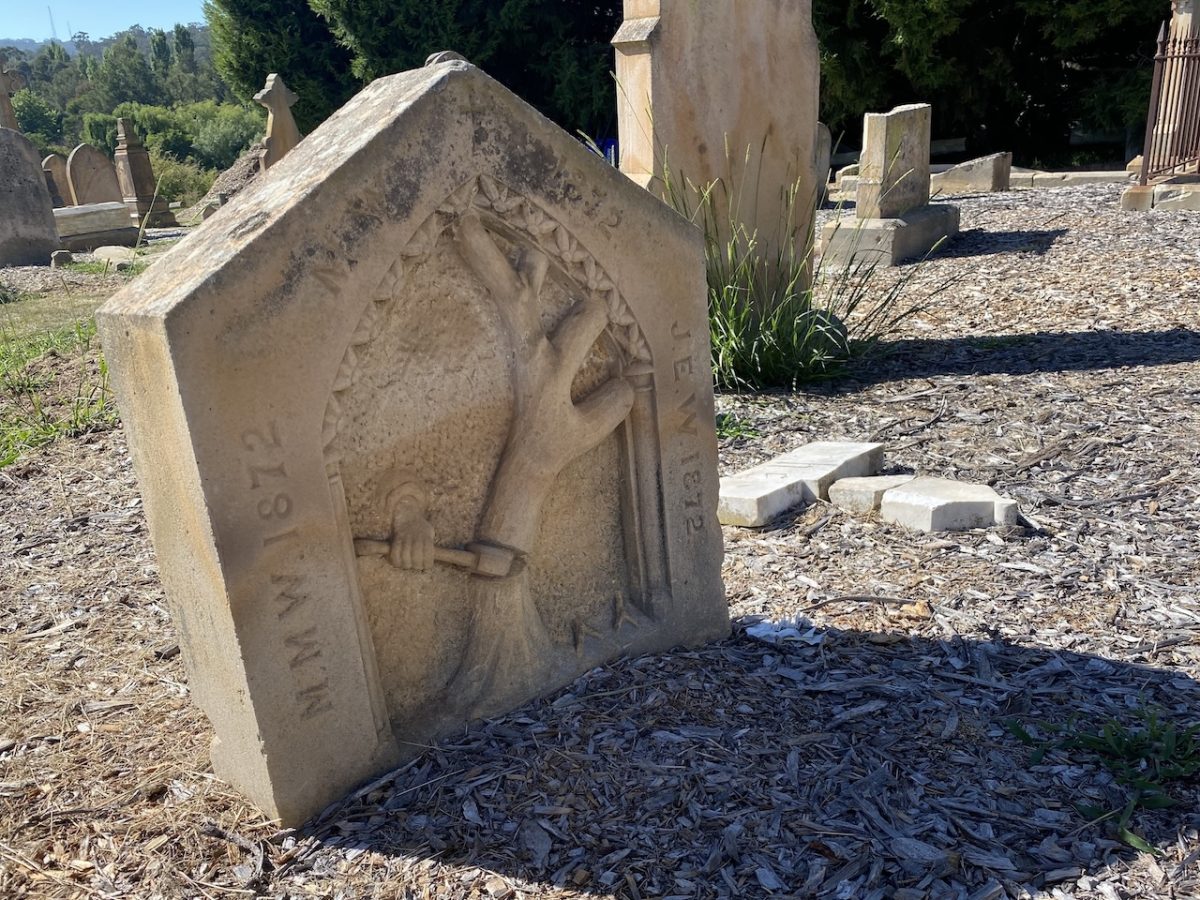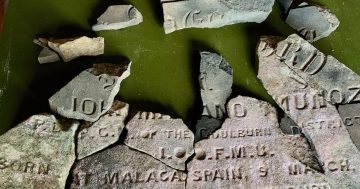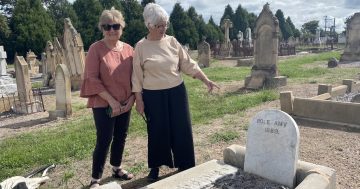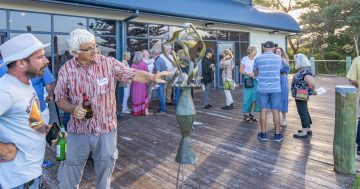
A tree symbolising life is cut down in this poignant footstone facing the headstone of the family grave of John and Marcella Warn and their three little children at Mortis Street Cemetery, Goulburn. Photo: John Thistleton.
On a bitterly cold August night in 1872, a young family of four fatally suffocated from the fumes of burnt charcoal as they huddled together in the one bed inside a home near Crookwell.
A small community numb with grief later erected an elaborate grave that today lies in pieces in Goulburn’s historic Mortis Street cemetery.
But their story is far from fading. Volunteers have researched, recorded and made accessible their sad passing with technology that will be unveiled later this month.
One of two families living in a six-bedroom home, John Warn, 28, his wife Marcella, 24, Matilda 3, and John junior, 22 months, slept with their bedroom door closed.
John’s brother, Henry, who lived in the same house with his wife, later told a coronial inquest that on the following morning, after he had been alerted to the tragedy, he noticed a tin dish full of charcoal pieces on their bedroom floor, partially burnt.
“My brother has been in the habit of taking some coals out of the fireplace and taking them into his room when he went to bed, almost every night; I have often seen him taking them with him to his bedroom,” Henry said.
A doctor Selby Morton told the inquest he believed the cause of death was asphyxia, caused by sulphurous acid or carbonic acid gas, or most likely the combination of both of them.
Accompanying the Warns’ story from this historic cemetery are many more about notable people, not always because of the circumstances of their death, but what they had achieved in life, including Jane Steer (1801-1884).
Believed to be one of the first white women in the Goulburn district, who was later the licensee of the Robbie Burns Hotel, she had also owned St Kilda boarding house in Beppo Street and had donated 1388 pounds – a fortune at the time – to Goulburn Hospital.
Friends of Goulburn Historic Cemeteries will unveil maps and locations of the gravesites, which have become tourist sites, at 10 am on Saturday 15 February. A growing amount of information about the early residents of Goulburn is linked to a website first unveiled in 2023 about historic cemeteries, including the Mortis Street Cemetery which is Goulburn’s first general cemetery for Catholics, Presbyterian and Wesleyan/Methodists.
Volunteers and energetic researchers Linda Cooper and Daphne Penalver recount years ago before volunteers arrived at the old cemetery when blackberries covered the graves and little information about the location of individual grave sites existed.
Volunteer Kim Baker has compiled data sheets and researched every name of the deceased interred in the cemetery. Volunteer Lynette Miller, after editing information coming to hand, has uploaded data onto the Historic Cemeteries website.
Her work followed former Goulburn resident Terry St George’s skilled efforts in creating the website, goulburnhistoriccemeteries.org.
Thanks to their work, and other volunteers, a QR code will lead visitors and next-of-kin and researchers on self-guided tours of notable people buried in the cemetery, including seven mayors, convicts and to memorials honouring soldiers killed during World War I in Italy and France.
Goulburn surveyor Justin Kell donated a large photograph of the cemetery taken from a drone for the signage. Veolia Trust donated money matched by service clubs, Saints Peter and Paul’s Old Cathedral, descendants of people buried in the cemetery, licensed clubs, Goulburn Produce, Lovell Meizer Funerals and Bunnings.
One of the best marble headstones belongs to William Duncan, a builder and monumental mason, who died at age 35, a remarkably short life given that he completed government contracts at Young jail, Yass police barracks, Gunning and Cootamundra court houses and police lock-ups at Goulburn, Picton, Camden, Marulan and Bungendore.
He also did stonework for the Church of England and St Patricks School, among many other projects.
He owned eight shops, a residence and the Robbie Burns Hotel in Goulburn and designed and built the William Ross memorial for the Masonic Lodge in Goulburn.
At another site, inscribed on the Waugh family’s monument, ‘Our little boy Teddy’ refers to the death of one of five children who died prematurely, including three who died in January, February and December, 1849.
Their father, medical practitioner Dr Robert Waugh lived in Goulburn for 32 years and created Waugh’s baking powder. He is buried in the grave as well, as is his wife, Ann Eliza Waugh.
Unveiling of Cemetery Maps and Legends will be held at 10 am on 15 February at the Mortis Street Cemetery, Cemetery Road, Goulburn. All welcome.










